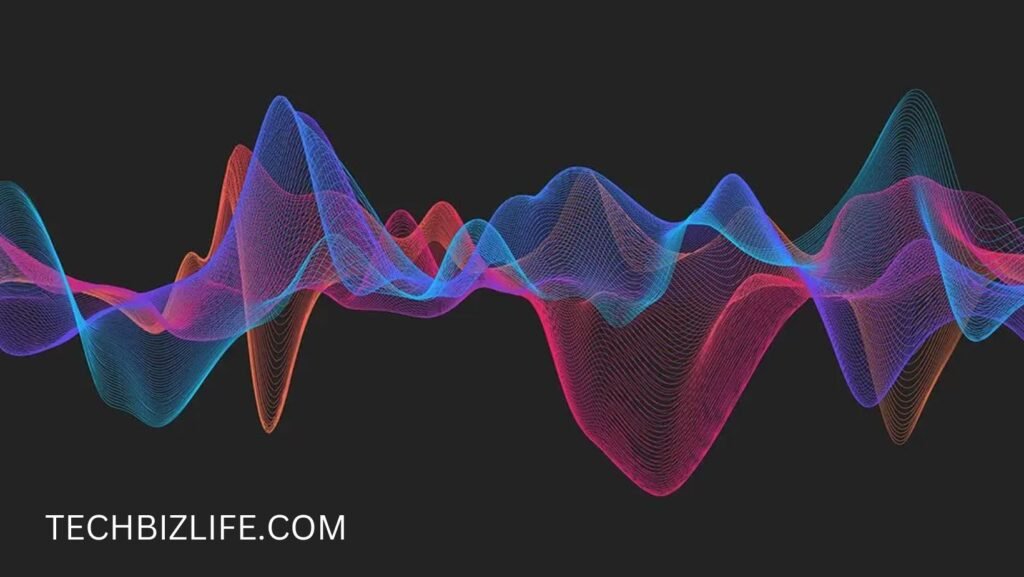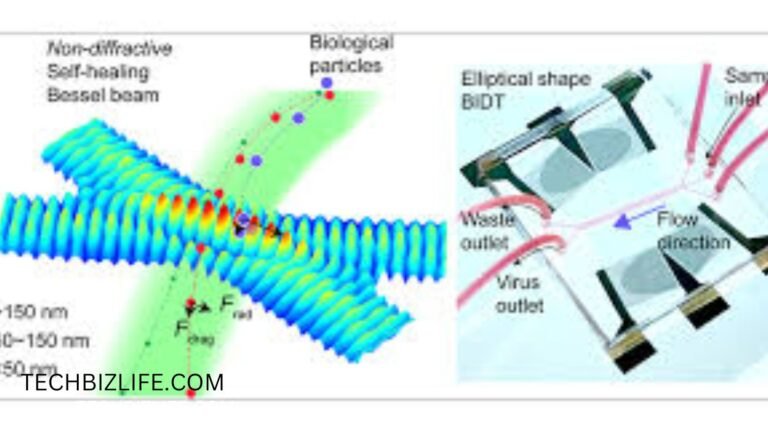The fight against infectious diseases depends on the development of sophisticated viral separation methods; acoustofluidic technology—more especially, Bessel beam excitation—is showing to be a revolutionary answer. Acoustofluidic virus isolation via bessel beam excitation separation technology. Combining acoustics with fluid dynamics, acoustofluidics controls particles—including viruses—in a liquid media. Researchers can improve the accuracy and efficiency of virus separation by use of Bessel beam excitation, therefore producing more accurate diagnosis findings and faster virus detection. This paper explores the mechanics, uses, and latest developments in acoustofluidic virus separation utilising Bessel beam excitation, therefore providing understanding of how this technology is transforming virus detection and diagnosis.
Key Takeaways
- Acoustofluidic technology uses sound waves to isolate viruses, offering a non-invasive, cost-effective solution for virus detection.
- Bessel beam excitation enhances the efficiency and precision of virus separation, allowing for better diagnostic accuracy.
- This technology is used in lab-on-chip devices, enabling portable virus testing in both clinical and field settings.
- Acoustofluidic virus isolation could significantly improve early virus detection, crucial in controlling viral outbreaks.
- The potential applications of acoustofluidic technology span multiple industries, from healthcare diagnostics to biotechnology research.
- Recent studies have shown a significant improvement in virus isolation efficiency with the integration of Bessel beam excitation.
Acoustofluidic virus isolation using bessel beam excitation: what is it?
Acoustofluidic virus isolation is a method for isolating particular components, such viruses, from complicated mixtures by means of sonic waves to control particles in a liquid. Bessel beam excitation applied in acoustofluidic systems improves the accuracy and efficiency of this process.
A Bessel beam is a kind of wave with a special, nondiffracting characteristic that lets it concentrate on a small, specified area even over a medium. In virus isolation, this feature is very helpful since it can target and isolate viruses from other particles without appreciable perturbation of the surrounding fluid. Highly selective technology is made possible by isolating viruses depending on size, mass, and acoustic characteristics by means of these beams in combination with acoustofluidic concepts.
Also Learn More: acoustofluidic virus isolation via bessel beam excitation separation technology
The Science Supporting Bessel Beam Excitation and Acoustofluidics
One must first know the fundamental ideas of acoustofluidics and the function of Bessel beams if one wants to properly appreciate how acoustofluidic viral isolation operates. Acoustofluidic virus isolation via bessel beam excitation separation technology. Acoustofluidics is the manipulation of particles by sound waves applied in a liquid environment. Particles can be moved, trapped, or isolated using these waves’ generated forces—radiation pressure and shear forces.
Bessel beam excitation brings still another degree of precision. Unlike typical sound waves, bessel beams show self-healing characteristics and can keep focus across greater distances, which makes them perfect for isolating tiny particles like viruses in a fluid media. These concentrated beams provide exact acoustic stresses, which helps viruses be separated from other particles with great accuracy.
Also Learn More: acoustofluidic virus isolation via bessel beam excitation separation technology
Important Components of Acoustofluidic Virus Isolation Systems
Systems of acoustofluidic viral isolation contain various elements that cooperate to provide effective virus separation. These parts consist of:
| Component | Description |
|---|---|
| Bessel Beam Excitation | A focused, nondiffracting sound wave that allows precise control over the movement of particles, including viruses. |
| Microfluidic Channels | Small channels that guide fluid flow and allow for the manipulation of particles at the microscopic level. |
| Ultrasonic Transducers | Devices that generate and transmit acoustic waves into the fluid medium. |
| Virus-Specific Capture Agents | Specialized agents or surfaces that can selectively capture or bind to specific viruses, enhancing isolation. |
These parts cooperate to effectively isolate viruses, therefore offering great sensitivity and specificity for virus detection.

Benefits of Bessel Beam Excitation Based Acoustofluidic Virus Isolation
Several benefits exist from using Bessel beam excitation in acoustofluidic systems over conventional viral isolation techniques, including:
- More exact control in isolating viruses from complicated samples is made possible by bessel beams’ highly concentrate and non-diffracting character.
- Unlike chemical or mechanical separation techniques, acoustofluidic virus isolation is non-invasive, so harm of the viruses is not cause during the process.
- Reduced Sample Contamination: Accurate diagnostics depend on accurate separation process contamination avoidance, hence the precision of Bessel beam excitation lowers the possibilities of contamination.
- Acoustofluidic systems fit portable, point-of-care virus testing in clinical and field environments since they may be include into lab-on-chip devices.
- More easily available for routine virus detection, this technology has the ability to lower the cost of virus isolation.
Uses of bessel beam excitation in acoustofluidic virus isolation
Bessel beam excitation-based acoustofluidic virus isolation finds extensive use in many different domains. Among the main places of use are some of:
- Early Virus Detection: This technique can greatly improve the capacity to identify viruses in the early phases of infection, so helping to limit viral outbreaks.
- Acoustofluidic devices’ portability makes them perfect for usage in remote or resource- constrained environments, where conventional diagnostic techniques would not be accessible.
- Acoustofluidic devices help researchers to separate certain viruses from complicated biological materials, therefore facilitating the study of viral behaviour, structure, and relationships.
- Acoustofluidic technology is beneficial in vaccine research and development since it allows one to isolate and concentrate viruses in a controlled environment.
- By use of continuous surveillance of viral diseases, this technique enables more accurate and prompt reporting of outbreaks.
Also Learn More: acoustofluidic virus isolation via bessel beam excitation separation technology
Acoustofluidic Virus Isolation: Recent Innovations
Recent studies using Bessel beam excitation have produced significant breakthroughs in acoustofluidic virus separation, so enhancing both efficiency and accuracy. Important progress includes:
- Researchers have modified Bessel beam settings to increase virus detection sensitivity, therefore enabling the isolation of viruses at lower concentrations.
- Acoustofluidic virus isolation systems are being progressively include into microfluidic platforms thereby enabling automate, high-throughput sample analysis.
- New technologies let virus isolation to be customise, therefore allowing the targeting of particular viruses, including those linke to newly occurring infectious illnesses.

Evaluating Acoustofluidic Virus Isolation Against Other Methods of Viral Separation
One of numerous benefits of acoustofluidic viral isolation over conventional methods of virus separation is Acoustofluidics and other approaches are compare here:
| Virus Separation Method | Advantages | Limitations |
|---|---|---|
| Acoustofluidic Isolation | Highly precise, non-invasive, cost-effective, scalable, portable | Limited adoption in clinical settings |
| Centrifugation | Well-established, effective for large samples | Time-consuming, may damage viruses |
| Magnetic Bead Separation | Selective, high specificity for certain viruses | Expensive, can introduce contamination |
| Filtration | Simple, fast, and inexpensive | Less selective, may not isolate all viruses |
Especially for its accuracy and capacity to separate viruses from complicated mixtures without using strong treatments, acoustofluidic technology is outstanding.
Problems and Future Directions
Although acoustofluidic viral isolation shows significant potential, several issues must be resolve before it may be used more widely:
- Current acoustofluidic systems are still being optimise for large-scale viral isolation, so obtaining high throughput still presents a difficulty.
- Integration with Other Diagnostic Tools: To achieve the best results, acoustofluidic technology must be use with other diagnostic techniques, including PCR testing, to provide thorough virus detection.
- Getting regulatory approval for acoustofluidic systems will need proving their safety and efficiency in clinical environments, as with any new technologies.
Notwithstanding these obstacles, the possibility of acoustofluidic virus isolation to transform virus detection and diagnostics is indisputable; continuous research keeps stretching the limits of what is feasible.
FAQs
How might excitation of a Bessel beam improve virus isolation?
To improve isolation efficiency, a bessel beam excitation enables exact, non-diffracting sound waves targeted on certain particles, such as viruses.
Is isolation of acoustofluidsic viruses relevant for every kind of virus?
If a virus has unique sonic characteristics that can be controlle, acoustofluidic technology can isolate a variety of viruses.
Over conventional techniques, what benefits exist from acoustofluidic viral isolation?
Higher precision, non-invasive techniques, and the possibility for more affordable, scalable, portable solutions abound from acoustofluidic viral isolation.
Is point-of-care diagnostics able to benefit from acoustofluidic virus isolation?
Indeed, especially in resource- constrained environments, the mobility and scalability of acoustofluidic devices make them perfect for point-of-care diagnostics.
For low viral concentrations, how sensitive is acoustofluidic virus isolation?
Acoustofluidic systems have been refine to detect and isolate viruses even at low concentrations, increasing sensitivity, especially when couple with Bessel beam excitation.
Which sectors stand to gain from the technology of acoustofluidic viral isolation?
A few businesses that can profit from acoustofluidic viral isolation include healthcare, biotechnology research, vaccine development, and infectious disease monitoring.
Conclusion
A major advancement in virus detection and diagnostics is represente by the isolation of acoustofluidic viruses using Bessel beam excitation. Acoustofluidic virus isolation via bessel beam excitation separation technology. This technology has the potential to completely change how viruses are isolate and investigate because of its accuracy, non-invasiveness, and affordability. The continuous advancements in acoustofluidic systems point to a promising future for this technology in both clinical and research contexts, despite the difficulties that still exist in scaling it and incorporating it into more comprehensive diagnostic frameworks. As acoustofluidic viral isolation develops further, it will have a significant impact on early virus detection, disease surveillance, and vaccine development, offering a potent weapon in the fight against infectious illnesses around the globe.


